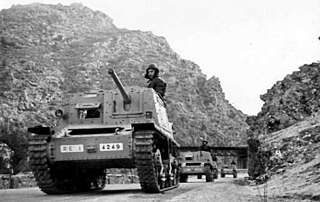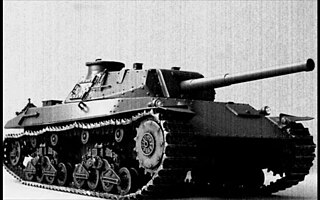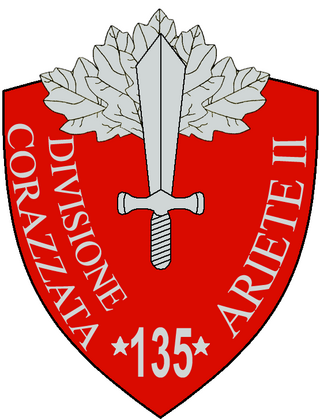
An assault gun is a type of self-propelled artillery which uses an infantry support gun mounted on a motorized chassis, normally an armored fighting vehicle, which are designed to provide direct fire support for infantry attacks, especially against other infantry or fortified positions. Assault guns were pioneered by the Soviet Union and Nazi Germany during the 1930s, initially being self-propelled guns with direct fire in mind, with Germany introducing the first purpose-built assault gun, the Sturmgeschütz III, in 1940.

A tank destroyer, tank hunter or tank killer is a type of armoured fighting vehicle, predominantly intended for anti-tank duties. They are typically armed with a direct fire artillery gun, also known as a self-propelled anti-tank gun, or missile launcher, also called an anti-tank missile carrier. The vehicles are designed specifically to engage and destroy enemy tanks, often with limited operational capacities.

The L6/40 was a light tank used by the Italian army from 1940 through World War II. It was designed by Ansaldo as an export product, and was adopted by the Italian Army when officials learned of the design and expressed interest. It was the main tank employed by the Italian forces fighting on the Eastern Front alongside the L6/40-based Semovente 47/32 self-propelled gun. L6/40s were also used in the North African campaign.

The Obice da 75/18 modello 34 was an Italian artillery piece used during World War II.

The Carro Armato M13/40 was an Italian World War II tank designed to replace the M11/39 in the Royal Italian Army at the start of World War II. It was the primary tank used by the Italians throughout the war. The design was influenced by the British Vickers 6-Ton and was based on the modified chassis of the earlier M11/39. Production of the M11/39 was cut short in order to get the M13/40 into production. The name refers to "M" for Medio (medium) according to the Italian tank weight standards at the time, 13 tonnes was the scheduled weight and 1940 the initial year of production.

The Carro Armato M15/42 was the last Italian medium tank produced during World War II. It was based on the earlier M13/40 and M14/41 medium tanks, and was built with the lessons from the North African Campaign in mind. The tank was meant to be a stopgap until the heavier P26/40 tank could be produced in numbers. It did not serve in North Africa, the theatre in which it was intended to operate, but served in Italy and in Yugoslavia with the German Wehrmacht.

The M 14/41 was a four-crew medium tank that served from 1941 in the Royal Italian Army. The official Italian designation was Carro Armato M 14/41. The tank was first employed in the North African Campaign where its shortcomings quickly became apparent.

The P 26/40 was an Italian World War II heavy tank. It was armed with a 75 mm gun and an 8 mm Breda machine gun, plus another optional machine gun in an anti-aircraft mount. Design had started in 1940 but very few had been built by the time Italy signed the armistice with the Allies in September 1943 and the few produced afterwards were used by the Germans.

The Autoblindo 40, 41 and 43 were Italian armoured cars produced by Fiat-Ansaldo and which saw service mainly during World War II. Most autoblinde were armed with a 20 mm Breda 35 autocannon and a coaxial 8 mm machine gun in a turret similar to the one fitted to the Fiat L6/40, and another hull mounted rear-facing 8 mm machine gun.

The Semovente L40 da 47/32 was an Italian self-propelled gun built during World War II. It was created by mounting a Cannone da 47/32 anti-tank gun in an open-topped, box-like superstructure on a L6/40 light tank chassis. Some were built as command tanks with a radio installed instead of the main gun. An 8 mm machine gun disguised as the 47 mm main gun was used on these versions to make them look like a regular Semovente 47/32s. About 400 Semoventi da 47/32 were built from 1941 onward. The Semovente da 47/32 was the most heavily armed Italian armoured fighting vehicle used on the Eastern Front.

The Semovente da 75/34 was an Italian self-propelled gun developed and used during World War II. It was a 75 mm L/34 gun mounted on a M15/42 tank chassis. It saw action during the defence of Rome in 1943 and later served with the Germans in Northern Italy and the Balkans. 170 were produced during the war.

The Semovente da 90/53 was a heavy Italian self-propelled gun and tank destroyer, used by the Italian and German Armies during World War II.

The Semovente da 149/40 was an Italian self-propelled artillery piece designed in 1942. Only a single unit was built; this vehicle is displayed at the US Army Ordnance Museum, Aberdeen, Maryland.

The Semovente da 75/18 was an Italian self-propelled gun of the Second World War. It was built by mounting the 75 mm Obice da 75/18 modello 34 mountain gun on the chassis of a M13/40, M14/41 or M15/42 tank. The first 60 were built using the M13/40 chassis and a subsequent 162 were built on the M14/41 chassis from 1941 to 1943. A total of 190 were built utilizing the M42 chassis before the armistice and an additional 55 were built afterwards. The Semovente da 75/18 was intended to be an interim vehicle until the heavier P40 tank could be available.

The Semovente da 75/46 was an Italian tank destroyer used during World War II.

Tanks have been employed by the military forces in Italy since their first use in World War I. They have had continued use in wars after and are still used through the modern day. The C1 Ariete is the current main battle tank of the Italian Army.

The P.43 Bis was a proposed Italian heavy tank designed in April 1943,. It was created as a direct continuation and replacement P26/40 tank; however only a prototype was manufactured at the end of the summer of 1943.

The 135th Armored Cavalry Division "Ariete" was an armored division of the Royal Italian Army during World War II. It was formed in 1943 and named to commemorate the 132nd Armored Division "Ariete", which had distinguished itself during the Western Desert campaign and was destroyed during the Second Battle of El Alamein. After the announcement of the Armistice of Cassibile on 8 September 1943 the division fought the invading German forces South of Rome. After two days the division was forced to surrender and was disbanded by the Germans on 12 September 1943.





















